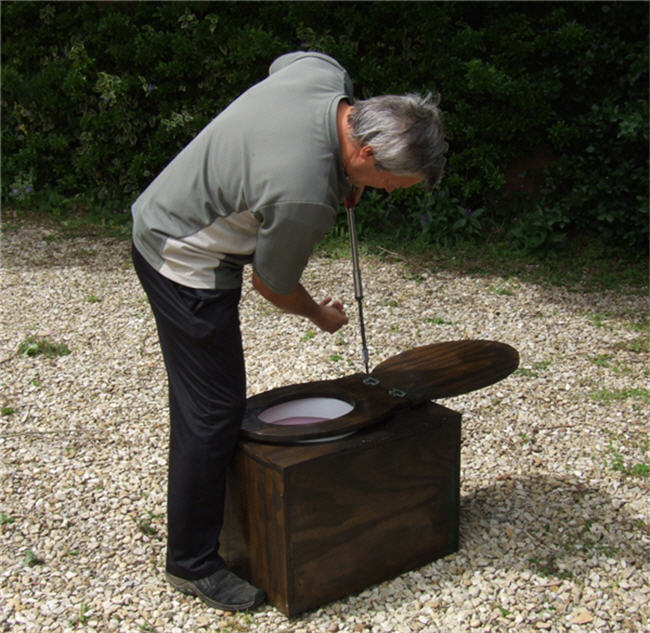Building a straw bale composting toilet
Introducing Part 1 of the Great Composting Toilet Project

At our new garden, there is no toilet. In summer, finding a hiding place is easy enough - there is a lot of cow parsley about - but it's a different matter in winter and early spring. What to do?
On the same site as us is a company of thatchers (Rumpelstiltskin Thatching Company), who rent a barn to store their straw and thatching equipment. Over the last few months we've been getting to know the owners Matt and Dave a bit, stopping by to say hello and have the occasional cup of tea.
The subject of a toilet has come up a few times and everyone agreed that we really could do with something proper on-site. Unbeknownst to us, they had mentioned the idea to the farm owner of building a composting toilet; at around the same time, me and Karl talked to the owner about composting toilets as well and what a fine idea they are. We'd used one for several months and know how they work. We explained the principles - Wikipedia explains it succinctly:
"A composting toilet is a closed unit, not connected to a sewage system or septic tank, used to receive, contain, and compost human waste via aerobic biodegradation or by dessication. In replacing a standard flush toilet the purpose of these units is the conservation of water resources otherwise used for flushing, while avoiding release of potentially pathogenic materials into the environment, and conserving useful nutrients for fertilizing home gardens."
The best discussion of composting toilets I have seen comes from Joseph Jenkins' excellent Humanure Handbook. Jenkins has had over 25 years of experience and his guide contains pretty much everything you can think of in relation to their design and working. There is a good sized section on pathogens and bacteria which should reassure even the most doubtful. What pathogens, though? We are, after all, healthy people. If one of us had a tape worm or Hepatitis, then it could be an issue, but we haven't and we don't.
The potential for problems caused by pathogens is one of the most quoted reasons against using composting toilets; however, Joseph Jenkins has thoroughly investigated this over many years and even in a worst case scenario, proper methods of thermophilic (heat) composting and aging allow for pathogen destruction:
"A different situation occurs when humanure from a highly pathogenic population is being composted. Such a population would be the residents of a hospital... or residents in a community where certain diseases are endemic. In that situation, the composter must take every effort necessary to ensure thermophilic composting, adequate aging time and adequate pathogen destruction."
The arguments for using composting toilets are compulsive, and Jenkins sums it up nicely:
"Thermophilic composting requires no electricity and therefore no coal combustion, no acid rain, no nuclear power plants, no nuclear waste, no petrochemicals and no consumption of fossil fuels. The composting process produces no waste, no pollutants and no toxic by-products. Thermophilic composting of humanure can be carried out century after century... with no stress on our ecosystems, no unnecessary consumption of resources and no garbage or sludge for our landfills. And all the while it will produce a valuable resource necessary for our survival while preventing the accumulation of dangerous and pathogenic waste."
The farm owner is a sensible, shrewd and practical woman and, after more discussion with the thatchers, she agreed to let us build a toilet as long as she didn't have to do anything. Fair enough. For her, it makes sense - we build it ourselves; no water is needed other than what we collect from the roof and the only other materials needed will end up helping her out (autumn leaves, weeds, grass clippings etc). So, we got together with Matt and Dave and started planning.
Being thatchers, they have plenty of straw and they'd wanted to play about with straw bale building for ages, as had we. Perfect. Within about fifteen minutes we'd got it all figured out: they would provide the materials for the building, put it together, thatch and render the walls, while we would prepare the chosen area (scythe down the nettles and brambles, cut back the hedge and measure up), build the actual toilet and put together the composting bays. They knew a source of the sawdust that we'll need to cover our 'doings'. All of the wood that we used for the toilet base and the composting bays was scavenged - some had been lying about the farm and other bits were donated by friends who were emigrating and having a big clear out. Several of the pieces just happened to fit perfectly, as happens with such things.
We arranged to start the following week, on Wednesday, and parted ways, looking forward to the project. I was looking forward to it immensely, not just because there would be a loo, but because it would just be so interesting. Traditional crafts have always fascinated me and we both enjoy working with our hands, without power tools, using hand tools instead and what strength we have. Helping to make something using low-tech, practical methods would be a wonderful opportunity.
Part 1 Part 2 Part 3 Part 4 Part 5 - all with lots of photographs
Garden Learning Projects - Overview

Adding the finishing touches to the toilet
© Copyright Miranda Hodgson 2009